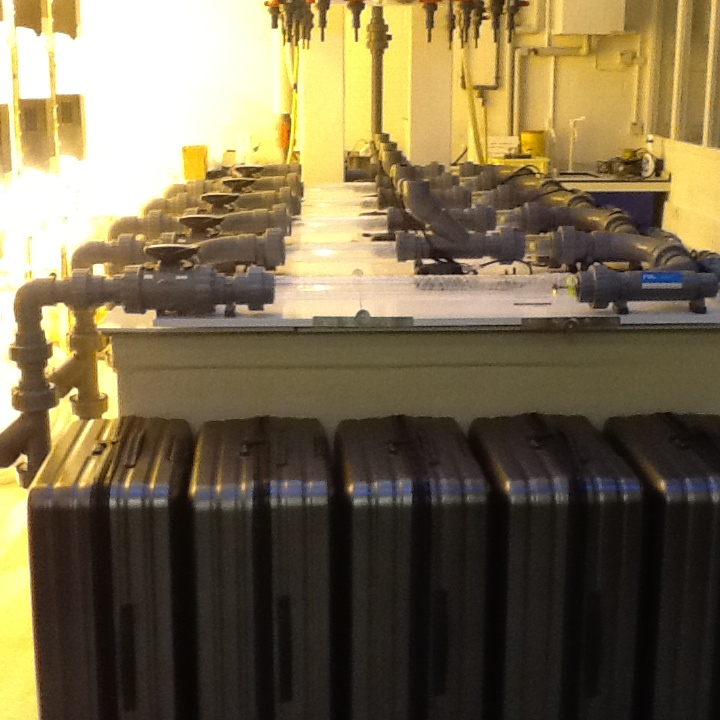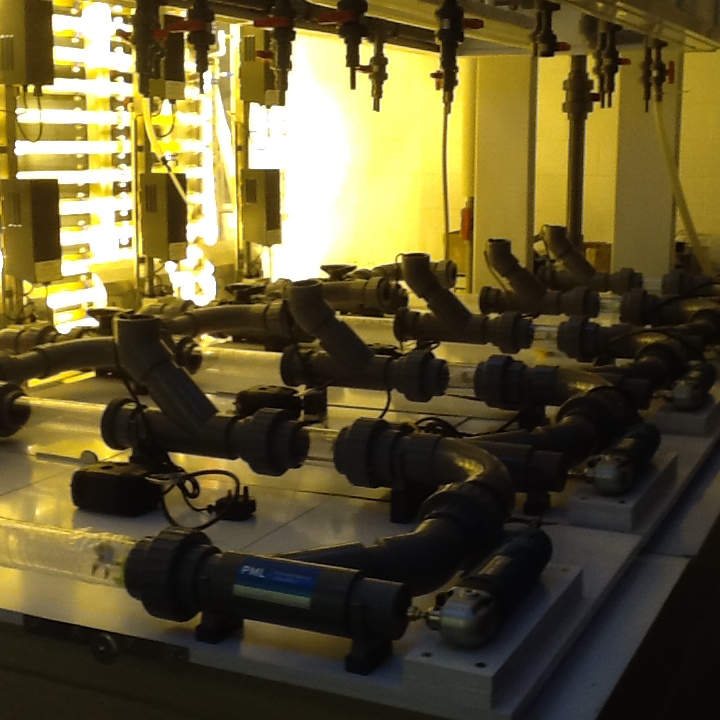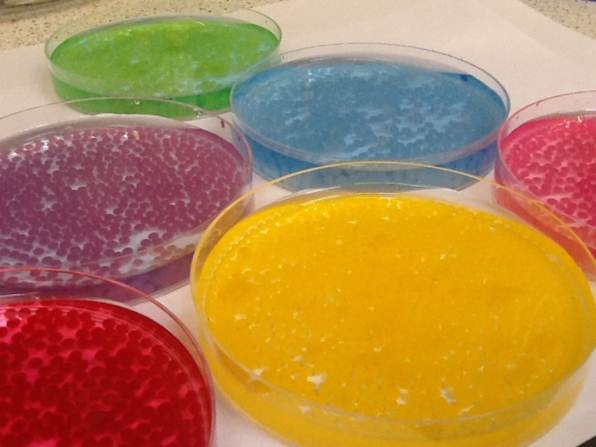- Forum
- categories
- Sanitation systems
- Various topics related to sanitation systems
- Vortex bioreactors for the processing of contaminated wastewater (Plymouth Marine Laboratory, UK)
Vortex bioreactors for the processing of contaminated wastewater (Plymouth Marine Laboratory, UK)
23.4k views
- mikeallen
-
 Topic Author
Topic Author- I'm a marine biologist by trade and a molecular biologist by training. I specialise in algal virology, in particular the giant viruses that infect E. huxleyi. I'm also interested in technology development and bioprocessing using vortex reactors and PBRs
Less- Posts: 9
- Karma: 2
- Likes received: 3
Re: Vortex bioreactors for the processing of contaminated wastewater (Plymouth Marine Laboratory, UK)
authors.elsevier.com/a/1QA7V_oMrMbx4y
Manuscript 3 available on PlosOne from December 23rd.
Journal of Water Process Engineering
April 2015, Vol.5:6–14, doi:10.1016/j.jwpe.2014.10.010
Swirl flow bioreactor containing dendritic copper-containing alginate beads: A potential rapid method for the eradication of Escherichia coli from waste water streams
Simon F. ThomasPaul RooksFabian RudinNeil CagneyStavroula BalabaniSov AtkinsonPaul GoddardRachel M. BransgrovePaul T. MasonMichael J. Allen
Abstract
Despite the increasing use of Decentralised Waste Water Systems (DEWATS) in the developing world, which effectively dewater sludge, the problem of preventing the pathogen-laden water produced by these systems from re-entering the food chain constitutes a continuing burden on developing countries, which hinders subsequent advancements. We report on a swirl flow reactor generating high mixing areas which in conjunction with Cu/alginate beads effectively reduces Escherichia coli numbers by five orders of magnitude in 10 min. The system is simple, low cost, portable and modular; it can be assembled with simple plastic plumbing parts available in most areas and, once further developed, may represent a useful adjunct for both existing and new DEWATS facilities.
Dr Mike Allen
Plymouth Marine Laboratory
Website: www.pml.ac.uk
Email: This email address is being protected from spambots. You need JavaScript enabled to view it.
Twitter: twitter.com/mike_j_allen
www.pml.ac.uk/about_us/the_pml_team/staf...tory/mike_allen.aspx
Please Log in to join the conversation.
You need to login to reply- mikeallen
-
 Topic Author
Topic Author- I'm a marine biologist by trade and a molecular biologist by training. I specialise in algal virology, in particular the giant viruses that infect E. huxleyi. I'm also interested in technology development and bioprocessing using vortex reactors and PBRs
Less- Posts: 9
- Karma: 2
- Likes received: 3
Re: Vortex bioreactors for the processing of contaminated wastewater (Plymouth Marine Laboratory, UK)
Quick update:
Swirl flow bioreactor containing dendritic copper-containing alginate beads: A potential rapid method for the eradication of Escherichia coli from waste water streams. Thomas et al, In press @ Journal of Water Process Engineering.
A comparison between ultraviolet disinfection and copper alginate beads within a
vortex bioreactor for the deactivation of bacteria in simulated waste streams with high
levels of colour, humic acid and suspended solids. Thomas et al, In press @ PLoSOne
You can also follow the group via Twitter now:
twitter.com/mike_j_allen
I'll post regular updates on the progress of various lab projects there, and links to the articles above when they made publically available.
Cheers
Mike
Dr Mike Allen
Plymouth Marine Laboratory
Website: www.pml.ac.uk
Email: This email address is being protected from spambots. You need JavaScript enabled to view it.
Twitter: twitter.com/mike_j_allen
www.pml.ac.uk/about_us/the_pml_team/staf...tory/mike_allen.aspx
Please Log in to join the conversation.
You need to login to reply- mikeallen
-
 Topic Author
Topic Author- I'm a marine biologist by trade and a molecular biologist by training. I specialise in algal virology, in particular the giant viruses that infect E. huxleyi. I'm also interested in technology development and bioprocessing using vortex reactors and PBRs
Less- Posts: 9
- Karma: 2
- Likes received: 3
Re: Vortex bioreactors for the processing of contaminated wastewater (Plymouth Marine Laboratory, UK)
As our 12 month project draws to a close, I thought I'd update you on progress.
Firstly, we've published the first part of the work describing the alginate beads and their bactericidal activity.
You can check out the paper here:
www.plosone.org/article/info%3Adoi%2F10....journal.pone.0096225
There's another manuscript on the bioreactor itself currently undergoing revisions at Journal of Water Process Engineering.
There's a second manuscript under review at PLoSOne on comparing the bioreactor with UV.
And a third manuscript describing the results from our field trials is currently under review at Nature Science Communications.
In the end we managed to get our reactors to:
- Chris Buckley's group in South Africa.
- Andrew Whitesell's group at Cascade Designs in Seattle.
- Bincy Baby at Eram Scientific in Kerala, India.
- Christoph Platzer in South America.
- And Ajeet Oak in Pune, India. We visited Ajeet's site for a week, earlier in the year to do our own field testing. It worked really well, we were all really happy with the performance of the system. The beads are letting us down a little, but we always knew they would need proper development in the future. The feedback on performance from partners has been really useful to us (Ajeet and Andrew's team are co-authors on the field work manuscript), and hopefully in the future we'll be able to go back to the partners with an updated and improved active agent.

That's all for now!
Cheers
Mike
Dr Mike Allen
Plymouth Marine Laboratory
Website: www.pml.ac.uk
Email: This email address is being protected from spambots. You need JavaScript enabled to view it.
Twitter: twitter.com/mike_j_allen
www.pml.ac.uk/about_us/the_pml_team/staf...tory/mike_allen.aspx
Please Log in to join the conversation.
You need to login to reply- mikeallen
-
 Topic Author
Topic Author- I'm a marine biologist by trade and a molecular biologist by training. I specialise in algal virology, in particular the giant viruses that infect E. huxleyi. I'm also interested in technology development and bioprocessing using vortex reactors and PBRs
Less- Posts: 9
- Karma: 2
- Likes received: 3
Re: Vortex bioreactors for the processing of contaminated wastewater (Plymouth Marine Laboratory, UK)
Dr Mike Allen
Plymouth Marine Laboratory
Website: www.pml.ac.uk
Email: This email address is being protected from spambots. You need JavaScript enabled to view it.
Twitter: twitter.com/mike_j_allen
www.pml.ac.uk/about_us/the_pml_team/staf...tory/mike_allen.aspx
Attachments:
-
 2014-02-12...2.30.jpg
(Filesize: 191KB)
2014-02-12...2.30.jpg
(Filesize: 191KB)
-
 2014-02-12...2.36.jpg
(Filesize: 185KB)
2014-02-12...2.36.jpg
(Filesize: 185KB)
-
 2014-02-12...2.48.jpg
(Filesize: 198KB)
2014-02-12...2.48.jpg
(Filesize: 198KB)
Please Log in to join the conversation.
You need to login to reply- mikeallen
-
 Topic Author
Topic Author- I'm a marine biologist by trade and a molecular biologist by training. I specialise in algal virology, in particular the giant viruses that infect E. huxleyi. I'm also interested in technology development and bioprocessing using vortex reactors and PBRs
Less- Posts: 9
- Karma: 2
- Likes received: 3
Re: Vortex bioreactors for the processing of contaminated wastewater (Plymouth Marine Laboratory, UK)
Thanks for your interest. I think burning will be the best way
With regards to the testing partners, yes that is still the plan. We should be sending out next week hopefully. We're working on the instruction video and manual this week, so we're getting very close. The partners will be trialling the very basic vortex bioreactor model, which takes about 8 litres of water and works in batch mode. We know this isn't going to be the final design, but its important we prove this can work in this format before we go changing and optimising the system. Our partners will be putting secondary effluent through, so there shouldn't be any detritus in the system (or at least not much!). The issue with having chunks of material in there is more to do with recycling the beads at the moment, I don't think it would have too much effect on its actual anti- microbiological activity. Vortex separators are commonly used in the waste water industry and they don't tend to clog. We'll know more when we get the data back......
Cheers
Mike
Dr Mike Allen
Plymouth Marine Laboratory
Website: www.pml.ac.uk
Email: This email address is being protected from spambots. You need JavaScript enabled to view it.
Twitter: twitter.com/mike_j_allen
www.pml.ac.uk/about_us/the_pml_team/staf...tory/mike_allen.aspx
Please Log in to join the conversation.
You need to login to reply- gitum
-

- Environmental Engineer pursuing PhD at Technical University of Munich
Less- Posts: 14
- Karma: 2
- Likes received: 4
Re: Vortex bioreactors for the processing of contaminated wastewater (Plymouth Marine Laboratory, UK)
I have seen in your post from 15 April that you have received the Phase 1 extension to deal with the helminth eggs. Could you please share some results that you received by now? Also, you wrote that you separate the eggs from the waste water. I am curious if there will be any additional method to destroy the eggs after you separate them. I think burning them could be a good solution in order to prevent contact.
You had written:
Main challenges / frustration: Dealing with the helminth issue, as they are quite indestructible chemically and are difficult to destroy at scale in an economical and efficient manner. We have decided not to destroy, but to SEPARATE the eggs out using either floating or sinking bead-binding materials and exploiting the separation properties of the vortex bioreactor. Results are looking promising, however the separation properties of the vortex bioreactor is antagonistic to the mixing properties (currently being applied very successfully to microbial destruction), therefore we need to tweak the system to address this. It is possible we’ll need a dual propeller system.
In terms of places to test your reactors in the field, you had also written on 15 April:
if we get Phase 2 funding, we’ll be providing vortex bioreactors to:
• Karl Linden, University of Colorado Boulder for UV comparison.
• Steve Sugden of Water for People will deploy the vortex bioreactor in Malawi and Uganda.
• Bincy Baby of Eram Scientific Solutions will utilize the vortex bioreactor in the field in Kerala, India.
• Chris Buckley and the team at University of KwaZulu-Natal will help develop the helminth binding add-on module to the vortex bioreactor.
Is this still the current plan? Could you tell us a bit more what will actually be involved, e.g. what will be the scale, type of waste or wastewater and type of pre-treatment system which you will use (as I imagine your beads could not possibly deal with things like toilet paper, rags, pieces of plastic, food chunks etc.)?
Thanks a lot.
Regards,
Gökce
Research Assistant
Technical University of Munich
e-mail: This email address is being protected from spambots. You need JavaScript enabled to view it.
www.tum-ias.de
www.sww.bv.tum.de
Please Log in to join the conversation.
You need to login to reply- mtfioravanti
-

- Researcher and advisor in Sustainable Development, Environmental education, Eco-efficiency, Sustainable Sanitation.
Less- Posts: 22
- Karma: 1
- Likes received: 3
Re: Vortex bioreactors for the processing of contaminated wastewater
Taladro de la Tierra Project
Fundación In Terris / Critical Practices LLC
This email address is being protected from spambots. You need JavaScript enabled to view it.
+593994492690
Skype: tomasini23
Please Log in to join the conversation.
You need to login to reply- mikeallen
-
 Topic Author
Topic Author- I'm a marine biologist by trade and a molecular biologist by training. I specialise in algal virology, in particular the giant viruses that infect E. huxleyi. I'm also interested in technology development and bioprocessing using vortex reactors and PBRs
Less- Posts: 9
- Karma: 2
- Likes received: 3
Re: Vortex bioreactors for the processing of contaminated wastewater
Thought I'd give a quick update of where we are currently at. The good news is that we have managed to secure Phase 2 funding. We are currently progressing two objectives:
1. Deployment of the vortex bioreactor in the field. (ETA late Jan/Feb)
2. Publication of the current results.
This current Phase 2 project is a much shortened project than originally envisaged, and will only last 12 months. Basically, the vortex bioreactor will be going to 4 designated BMGF partners and will hopefully provide the proof of principle data we need to secure the next phase of funding. Nothing will change with the existing setup in the next 12 months, we will be concentrating on consolidating what we've got already and proving it can work in the real world. Although we know the propeller, the beads and system design will all require significant modification in the future, this will have to wait until after we have shown it can work in its current format.
Exciting times ahead. I'll keep you all updated as things progress.....
Cheers
Mike
Dr Mike Allen
Plymouth Marine Laboratory
Website: www.pml.ac.uk
Email: This email address is being protected from spambots. You need JavaScript enabled to view it.
Twitter: twitter.com/mike_j_allen
www.pml.ac.uk/about_us/the_pml_team/staf...tory/mike_allen.aspx
Please Log in to join the conversation.
You need to login to reply- mikeallen
-
 Topic Author
Topic Author- I'm a marine biologist by trade and a molecular biologist by training. I specialise in algal virology, in particular the giant viruses that infect E. huxleyi. I'm also interested in technology development and bioprocessing using vortex reactors and PBRs
Less- Posts: 9
- Karma: 2
- Likes received: 3
Re: Vortex bioreactors for the processing of contaminated wastewater
Thanks for your continued interest, clearly you have seen the potential of the vortex bioreactor. It would be a pleasure to provide you with a unit to test should our phase 2 application get funded. Can you email me on This email address is being protected from spambots. You need JavaScript enabled to view it. with your contact details and a few lines on where and what you'll want to connect it to?
In response to your queries….
1. It’s all about contact. A mixing tank is fine, but the vortex reactor brings about intense and efficient mixing which is why it is quick and effective. With a holding/mixing tank it’ll take longer. Which is absolutely fine, but is a different technology niche. Our collaborators on the vortex reactor technology are also developing this type of product (1 tonne scale). I can send you details if you’re interested.
2. Wow, I had no idea we had based our beads on sweets. I suppose the coloured ones did look a bit like skittles…. When we turn up the speed the beads do suffer from some damage. However at the lower speeds that we have been running the vortex reactor at, we have seen no degradation. They don’t actually make contact with the propeller, they just glide by it. So it is not as damaging or abrasive as you would think. Nevertheless, we have updated the design of the system to have the bead return manifold just after the propeller and directly feeding into the mixing zone. So they should never ever come in to contact with the propeller. There is minor leaching of the copper into the effluent, but it is very low at the moment. We don’t use that much copper in the first place (see below). We also have another compound which we can put in which will soak it up as an additional processing step.
3. Not many at all, we used about 50 g of beads per litre, which are 4% copper. So there’s about 2 g of copper per litre in total. They are easy to separate and retain, and won’t need replacing or topping up for months I imagine. But we need to do field tests to confirm this.
4. We’ve used it up to 20% solids using insoluble starch. Increasing the solids will of course make the intense contact more difficult and require more energy. We’re not looking to treat sludge though, just contaminated water.
5. You’re the second person to contact me in the last few days about replacing chlorination systems in waste water plants. I think there is a definite application there for this technology. You need a reactor to test!!
Cheers
Mike
Dr Mike Allen
Plymouth Marine Laboratory
Website: www.pml.ac.uk
Email: This email address is being protected from spambots. You need JavaScript enabled to view it.
Twitter: twitter.com/mike_j_allen
www.pml.ac.uk/about_us/the_pml_team/staf...tory/mike_allen.aspx
Please Log in to join the conversation.
You need to login to replyRe: Vortex bioreactors for the processing of contaminated wastewater
thanks for the answer, the alginate beads are more or less as I imagined. I am very interested for the disinfection of regular wastewater, therefore my questions:
1) You do need 3-5 min for reaction (currently). I would do a mixing tank instead of a vortex reactor. Should it not be enough? Just to guarantee very good mixing? I´m thinking of up to 2 l/s, that makes a reactor of 360 – 600 l. Is there another reason for the Vortex mixing?
2) The alginate beads are more or less as sagoo (a Brazilian sweet
3) How many of the alginate beads I do need / l,s or whatever measure
I am trying to imagine how many beads I do have to have, how difficult it would be to bring those back after separation (which I think is an issue), how many I do have to replace each day.
Maybe it is just a solution for very low volume with a very high pollution. Up to 50 kg/m³ is a lot of solid. Are you sure about 5%? It would be as if you use a very, very dense sludge after a thickener. Separation in this material is quite more difficult I guess.
Dealing with sludge helminth eggs would definitely the most important issue. Dealing with wastewater is more the coliforms..therefore my questions towards wastewater.
Thanks in advance ..and if you are not able to answer everything ..as you are right now researching…no problem I was “dreaming” of a substitute for my chlorination I put in in the small wastewater plants.. I can keep on dreaming a bit
Yours
Christoph
Please Log in to join the conversation.
You need to login to reply- mikeallen
-
 Topic Author
Topic Author- I'm a marine biologist by trade and a molecular biologist by training. I specialise in algal virology, in particular the giant viruses that infect E. huxleyi. I'm also interested in technology development and bioprocessing using vortex reactors and PBRs
Less- Posts: 9
- Karma: 2
- Likes received: 3
Re: Vortex bioreactors for the processing of contaminated wastewater
Thanks for your interest. OK, currently in order to immobilise our active ingredient (copper powder) we encase it in an alginate matrix. By placing it inside the alginate bead (which are about 3-4 mm across), we can recycle our copper by retaining the beads easily by either particle size retention (with a mesh) or by directing it down a separation manifold for the heavy fraction. If we wished to do so, we can even make the copper alginate beads float by adding 3M glass bubbles to the mix as we form the beads although this is a lot messier and a little trickier. When the beads float we can separate them through the light liquid manifold like the fishing tackle beads were doing in the model reactor we showcased in Seattle last year.
There are plenty of papers on making alginate beads, it’s not a new concept and its very easy. Just put “alginate bead” into google scholar. People use them for all sorts or purposes. We originally became aware of the technique because we were encapsulating single cells inside them, they are a great way of growing mixed microbial communities in the same pot, whilst keeping the different types of bacteria physically separate.
Cheers
Mike
Here are some pictures of coloured beads that we made of various densities to track the fluid dynamics within the system (coloured with food dye from Tescos) and of our copper beads we use to kill the bugs.
Dr Mike Allen
Plymouth Marine Laboratory
Website: www.pml.ac.uk
Email: This email address is being protected from spambots. You need JavaScript enabled to view it.
Twitter: twitter.com/mike_j_allen
www.pml.ac.uk/about_us/the_pml_team/staf...tory/mike_allen.aspx
Attachments:
-
 beads1.jpg
(Filesize: 27KB)
beads1.jpg
(Filesize: 27KB)
-
 beads2.jpg
(Filesize: 28KB)
beads2.jpg
(Filesize: 28KB)
Please Log in to join the conversation.
You need to login to replyRe: Vortex bioreactors for the processing of contaminated wastewater
very interesting project. I have tons of questions but to be able to ask better, I would like to ask you to explain a bit about "a fully recyclable copper-alginate bead".
Could you link a paper on that? I never heard of such. It seems to be very interesting.
Thanks for posting.
Christoph
Please Log in to join the conversation.
You need to login to reply- Forum
- categories
- Sanitation systems
- Various topics related to sanitation systems
- Vortex bioreactors for the processing of contaminated wastewater (Plymouth Marine Laboratory, UK)







